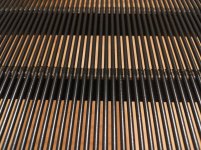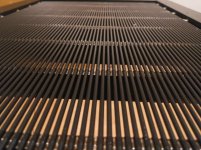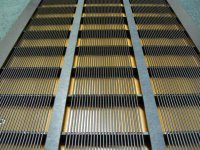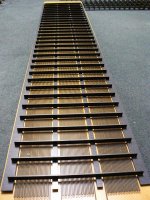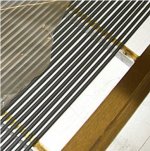Hi there , im trying to glue my PVC insultated wires on a HPL frame.
i used 2 component epoxy glue, after 10 hours drying at room temp. it sticks well to the HPL, but all the wires just come lose. is there another glue i need to use? its pretty anoying caus i cant use the wires anymore nor the frame.
i used 2 component epoxy glue, after 10 hours drying at room temp. it sticks well to the HPL, but all the wires just come lose. is there another glue i need to use? its pretty anoying caus i cant use the wires anymore nor the frame.
Hi there , im trying to glue my PVC insultated wires on a HPL frame.
i used 2 component epoxy glue, after 10 hours drying at room temp. it sticks well to the HPL, but all the wires just come lose. is there another glue i need to use? its pretty anoying caus i cant use the wires anymore nor the frame.
Hi,
What is the gluing technique that you are using to bond wires? From my experience slow curing epoxy encapsulates wires very well and gives a strong bond. That's assuming glue is applied on top of wires via syringe and is allowed so sag.
Maybe HPL aborbs most of epoxy leaving a starved joint?
Another glue that worked very well out of my many experiments is PVA - and panels which were build using it 5 years ago still work without a single loose wire. Different grades of PVA can give somewhat different results in terms of adhesion strength.
Take your time and do sufficient amount of experiments before final assembly.
Regards,
Lukas.
yeah i just bought PU 2 component contruction glue, some dutch guy that made DIy esl used it with HPL so i give i a try, pretty expensive i must ad  although its almost 800 grams so it will last some time as well. i just glued a few wires on HPL 2 pieces of HPL together and a batch of 8 wires under tension in the rig, will post the results tomorow , hope it finally stays where it belongs
although its almost 800 grams so it will last some time as well. i just glued a few wires on HPL 2 pieces of HPL together and a batch of 8 wires under tension in the rig, will post the results tomorow , hope it finally stays where it belongs 
funny part is its ment for wood, but it can glue wood to most other opbjects so.
Lukas the PVA glue is'nt that water based glue >? for wood and paper and stuff ? if that would work that would be way cheaper and also i dont have to mix the 2 components
thanks for the reply Lukas!
funny part is its ment for wood, but it can glue wood to most other opbjects so.
Lukas the PVA glue is'nt that water based glue >? for wood and paper and stuff ? if that would work that would be way cheaper and also i dont have to mix the 2 components
thanks for the reply Lukas!
yeah i just bought PU 2 component contruction glue, some dutch guy that made DIy esl used it with HPL so i give i a try, pretty expensive i must adalthough its almost 800 grams so it will last some time as well. i just glued a few wires on HPL 2 pieces of HPL together and a batch of 8 wires under tension in the rig, will post the results tomorow , hope it finally stays where it belongs
funny part is its ment for wood, but it can glue wood to most other opbjects so.
Lukas the PVA glue is'nt that water based glue >? for wood and paper and stuff ? if that would work that would be way cheaper and also i dont have to mix the 2 components
thanks for the reply Lukas!
Hi,
Yeah, that's the same white water-based glue for wood. There are different grades of it, some are more resistant to moisture than others. Look for one which has most resistance to water you can find and not too thin running. Later you can dilute it to right viscosity with water. Also there are some grades with hardeners which I have not tested but those might be even better.
I used "class D3" PVA glue which seems to work well.
There was an accident when a heavy tool dropped onto panel on outside. It has bent several wires and stretched copper core considerably. However PVC insulation survived and the glue didn't let it go! That was kind of surprise to me.
Good luck and be sure to test several times before final gluing procedure.
By the way, any pics?
Lukas.
Last edited:
If you are gluing to the the composite side of the HPL then you may need some sort of primer coating.
Maybe some thing like a polyurethane or varnish of some sort as the stuff is composed of pulverized paper much like MDF.
Just like sticky tapes won't hold to plywood very well or at all.
I recently have a project were I need to use some double side tape to stick some appliance rollers to a plywood base for my stacked washer and dryer.
But I know from past experience that I will need to coat the wood with something before the tape will stick properly.
I have had similar instances with epoxy on some materials as well, such as on composite press board (particleboard), the kind that is made out of sawdust.
As mentioned a PVA glue may work well as a primer than a oil based polyurethane will as the oil's in it may hender the epoxies adhesion ablility until it cures out, and, that can take a long time to do.
FWIW
jer
Maybe some thing like a polyurethane or varnish of some sort as the stuff is composed of pulverized paper much like MDF.
Just like sticky tapes won't hold to plywood very well or at all.
I recently have a project were I need to use some double side tape to stick some appliance rollers to a plywood base for my stacked washer and dryer.
But I know from past experience that I will need to coat the wood with something before the tape will stick properly.
I have had similar instances with epoxy on some materials as well, such as on composite press board (particleboard), the kind that is made out of sawdust.
As mentioned a PVA glue may work well as a primer than a oil based polyurethane will as the oil's in it may hender the epoxies adhesion ablility until it cures out, and, that can take a long time to do.
FWIW
jer
Last edited:
Thanks all!!! . i will will try the normal wood glue as well, theres 2 diferent versions 1 for outdoors and one only for indoor. i probably try the oudoor one component version.
The 2 component stuff i got now is also for wood. but i mixing the 2 components is verry anoying and waiting for 48 hours is also not really my thing
The 2 component stuff i got now is also for wood. but i mixing the 2 components is verry anoying and waiting for 48 hours is also not really my thing
damned ,,
Houtlijm Extra Producten - Bison
this is the wood glue you used its like 6 times cheaper
its like 6 times cheaper haha
haha
theres also a quicker version but its classified as D2 indoor only. so im not sure that one works to. it will dry in 10 minutes wich sounds like music in my ears. might try it i can always use it for wood if it fails
Houtlijm Extra Producten - Bison
this is the wood glue you used
theres also a quicker version but its classified as D2 indoor only. so im not sure that one works to. it will dry in 10 minutes wich sounds like music in my ears. might try it i can always use it for wood if it fails
some more failures today. the expensive 2 component version does not hold well enough on the wires.... also bought a wood glue version wich should be hardened in 30 minutes, but after an hour it just lets go when i get it out of the stretcher.
i tried some Hot glue now, and this might be the stuff im looking for, it fills gaps easy and adhesive to the pvc much better then all the other products.
only anoying thing is ofcourse the extreme fast setting time. its nice to glue fast but this is insane. thank god i just can get the paint burner and reheat the glue.
i will make some pictures when i got the procedure right. for now i got a small panel playing, but the big ones have more supports hence more glueing hence more hard time with the stting time of the hot glue
The best thing would be to use the hot glue at bottom and top, it takes all the force, then somehow glue the rest of the supports. i want a frame to leave the stretching jig as fast as possible.
i tried some Hot glue now, and this might be the stuff im looking for, it fills gaps easy and adhesive to the pvc much better then all the other products.
only anoying thing is ofcourse the extreme fast setting time. its nice to glue fast but this is insane. thank god i just can get the paint burner and reheat the glue.
i will make some pictures when i got the procedure right. for now i got a small panel playing, but the big ones have more supports hence more glueing hence more hard time with the stting time of the hot glue
The best thing would be to use the hot glue at bottom and top, it takes all the force, then somehow glue the rest of the supports. i want a frame to leave the stretching jig as fast as possible.
Jim Strickland of Acoustat did not glue his stator wires into place he encapsulated them. The frames are styrene so he simply made a thick syrup of styrene plastic and solvent. The off gas is not good and you need to do this out of doors. but you might give that a try. Hope this is of interest. Best regards Moray James.
Hi,
It is difficult to tell what you are doing wrong without seeing pictures.I have to say that both epoxy and PVA glue worked very well to me.
Some hints:
1) Do not glue wires under high tension; at first it must be stretched into plastic deformation zone and then released somewhat
2) Solid core wire is very much preferable because it does not lose tension
3) As M.James wrote wires should be encapsulated(i.e glue applied on top of insulation and allowed to sag into cross bars). That means wires are held not by adhesion force but tensile strength of glue(assuming it adheres well to cross bars)
4) Cross bars should not absorb too much glue, i.e it might need some kind of priming depending on base material.
Here are some of pictures from a panel build using epoxy + marine grade ply for cross bars to get an idea:
It is difficult to tell what you are doing wrong without seeing pictures.I have to say that both epoxy and PVA glue worked very well to me.
Some hints:
1) Do not glue wires under high tension; at first it must be stretched into plastic deformation zone and then released somewhat
2) Solid core wire is very much preferable because it does not lose tension
3) As M.James wrote wires should be encapsulated(i.e glue applied on top of insulation and allowed to sag into cross bars). That means wires are held not by adhesion force but tensile strength of glue(assuming it adheres well to cross bars)
4) Cross bars should not absorb too much glue, i.e it might need some kind of priming depending on base material.
Here are some of pictures from a panel build using epoxy + marine grade ply for cross bars to get an idea:
Attachments
Last edited:
Hi,
It is difficult to tell what you are doing wrong without seeing pictures.I have to say that both epoxy and PVA glue worked very well to me.
Some hints:
1) Do not glue wires under high tension; at first it must be stretched into plastic deformation zone and then released somewhat
2) Solid core wire is very much preferable because it does not lose tension
3) As M.James wrote wires should be encapsulated(i.e glue applied on top of insulation and allowed to sag into cross bars). That means wires are held not by adhesion force but tensile strength of glue(assuming it adheres well to cross bars)
4) Cross bars should not absorb too much glue, i.e it might need some kind of priming depending on base material.
Here are some of pictures from a panel build using epoxy + marine grade ply for cross bars to get an idea:
nice pics verry straight!!! i can see you put the glue on the wires and let it soak down. this might work with all the glues i used. but i must say speed is an isue with me
for instance i know use my cnc to mill one stator, the only problem is if i let him mill the spacer, say 1 mm, i run into the problem that my table is not level 1 mm all the way. its almost impossible when using a woodden spoil board (moisture and stuff or previous cut pieces leave marks in the bed)
so i mill the space where the wire need to go deeper then 3 lets say 3.5 the wire is 2 mm and the stator membrane spacing need to be 1 mm.
what i am trying right now is to use hot glue. and use a slightly bigger amount then needed to only tack it down. i want to fill up the 0,5 ~ mm i milled deeper then i needed. i heat the glue extra with a heat gun unltil its really soft. at top and bottom of the stator i glue the wires create the needed DC spacing of 1 mm and glue the 1 mm pvc that covers the wire in one go.the the glue i used to much comes out between the wires. so it all sits snug.
the supports i want to do the same, only problem there is that i dont want to glue the Pvc 1mm thick plastic on top of the wires, i only want to use it to set the spacing between wire and the frame where the menbrame gets sticked on. so now im looking for a simple tool wich i can press on the wires when the glue is hot wich does not sticks to the glue because i want to remove it when the glue cools down.
i tried using silicone spray on the tool this worked but not super, tomorow i create the tools/press from a piece of HPL and stick a piece of baking paper on the botom so it wont stick to the glue.
this all seems pretty much work just to glue a stator, but in the end i can create stator frames with a mouse click, and when the CNc is cutting i can stretch the wires, glue them right in and after a few minutes the glue is set and ready for duty.
sorry for the long story, i hope to make pictures soon , its hard to explain stuf in a non native language
i see you use seperate supports for the wires. i thought about this option to because then i would not have the problem with uneven cutting bed of the CNC machine. but i relaly like the fact of running the progamm, doing something else and come back to see a frame ready for wires
Last edited:
nice pics verry straight!!! i can see you put the glue on the wires and let it soak down. this might work with all the glues i used. but i must say speed is an isue with meno patience so it seems
. i always keep speed in mind.
There are certain epoxies made that will bond to PVC so that encapsulating the wire is not necessary. If you call a major manufacturer of epoxy adhesives with a description of the materials you are wanting to bond they should be able to recommend one of more products to try.
But if speed is important, you might consider looking at some of the CA adhesives formulated for plastics, rubber, etc.
As an example, Loctite 406 should work well.
http://www.loctite.co.uk/fullproduct-list-loctite-4995.htm?redDotUID=1000000IGQR
It bonds PVC to metal or phenolic with great strength. If you try to pull the wire off the cross bar, the PVC insulation fails before the glue joint does. Attachment 1 & 2 show some stators I made with Loctite 406. You can see there is no white film around the glue joint that is typical of most CA adhesives. It is also very low odor.
More details on materials and construction technique in this thread:
http://www.diyaudio.com/forums/plan...sl-project-file-translated-2.html#post2244354
I second Bazukaz recommendation to try out adhesives on small scale tests before using it on your large stator frames.
I tested many(10+) promising adhesives before finding ones that bonded well to the materials I was using.
Attachment 3 shows the glue joints for an Audiostatic ES-100 stator.
The adhesive used is tan in color and does NOT encapsulate the wire.
Crossbars are anodized aluminum. Anybody have any idea what it might be?
Attachments
Last edited:
Hi,
Your suggestion to use super glue is quite intriguing as working with epoxy is slow and tricky. I've never used cyanoacrylate due to concerns of possibly damaging PVC insulation. Have you tried to inspect if this glue does any damage to it below surface?
By the way, nice looking stators. Have you finished the project?
Regards,
Lukas.
Your suggestion to use super glue is quite intriguing as working with epoxy is slow and tricky. I've never used cyanoacrylate due to concerns of possibly damaging PVC insulation. Have you tried to inspect if this glue does any damage to it below surface?
By the way, nice looking stators. Have you finished the project?
Regards,
Lukas.
As with epoxy, there are many, many types of CA glue most of which won't bond well with PVC and/or will damage it. The particular product I mentioned was one I found that bonded strongly to PVC without damaging it(I'm sure there are others). It's a little pricey, but if you are in a hurry...I've never used cyanoacrylate due to concerns of possibly damaging PVC insulation. Have you tried to inspect if this glue does any damage to it below surface? By the way, nice looking stators. Have you finished the project?
The stator pics are from some panels completed in 2009. They were used for experiments to validate segmented stator line source theories and models mentioned in many threads on this forum. They are retired from testing duties, now happily playing music instead of being tortured with test tones.
HPL is a type of phenolic, basically a resin impregnated paper laminate sheet.Ok i'm lost what is HPL.
Nice looking stators again !!! Real slick. Well i might be cutting corners here. With th stator design. But i really enjoyed drinking à cofee and 10 minutes later one stator part was ready for the glue  . I recon my way of working might not be the best approach but I think I do learn allot from it and could help the final design to be made as cost/time efficient as possible.
. I recon my way of working might not be the best approach but I think I do learn allot from it and could help the final design to be made as cost/time efficient as possible.
Btw the lock tight !!! Verry nice I've seen the product when I was glue shopping but thought it to be for lOcking nuts. if the hot glue setup turns out to fail completely I buy some of the locktight.
I'm gone for few days but when I'm back I'll post some pics, right now they don't look as slick as yours, havin problems with nails being to smal. The wire with insulation is 2 mm I forgot that the insulation wil deforme when putting the wire aroUnd the nail. Way before the copper stretches. This result in uneven spacing of the wires
Btw the lock tight !!! Verry nice I've seen the product when I was glue shopping but thought it to be for lOcking nuts. if the hot glue setup turns out to fail completely I buy some of the locktight.
I'm gone for few days but when I'm back I'll post some pics, right now they don't look as slick as yours, havin problems with nails being to smal. The wire with insulation is 2 mm I forgot that the insulation wil deforme when putting the wire aroUnd the nail. Way before the copper stretches. This result in uneven spacing of the wires
Nice looking stators again !!! Real slick. Well i might be cutting corners here. With th stator design. But i really enjoyed drinking à cofee and 10 minutes later one stator part was ready for the glue. I recon my way of working might not be the best approach but I think I do learn allot from it and could help the final design to be made as cost/time efficient as possible.
Btw the lock tight !!! Verry nice I've seen the product when I was glue shopping but thought it to be for lOcking nuts. if the hot glue setup turns out to fail completely I buy some of the locktight.
I'm gone for few days but when I'm back I'll post some pics, right now they don't look as slick as yours, havin problems with nails being to smal. The wire with insulation is 2 mm I forgot that the insulation wil deforme when putting the wire aroUnd the nail. Way before the copper stretches. This result in uneven spacing of the wires
Well, its nice you have a CNC. It might help a lot.
However one of the first lessons I have learned(from lots of failures) was to work slow and re-think again and again before proceeding. And do not put cost as one of top priorities... #1 rule what's the best way, #2 isn't it too difficult or costly, #3 make some tests, #4 don't work too much every day... Well that's my check-list
Good luck with your work.
Lukas.
Hello, I am using 2K-Epoxy, UHU-endfest. It is curing very slowly, takes about 12 hours. It works fine and is a great help for me, because I never have to worry about working too fast. While waiting I think about the next step.
Once I wanted to try CA-glue, thats fast! After glueing the stators together, there was silence........ No wonder, I forgot to apply the coating..
Once I wanted to try CA-glue, thats fast! After glueing the stators together, there was silence........ No wonder, I forgot to apply the coating..
- Status
- This old topic is closed. If you want to reopen this topic, contact a moderator using the "Report Post" button.
- Home
- Loudspeakers
- Planars & Exotics
- Glue for wire stators
